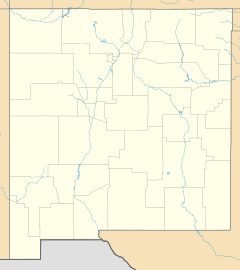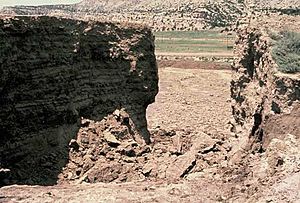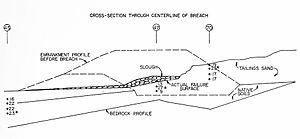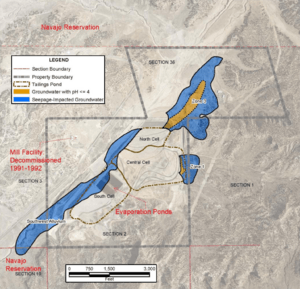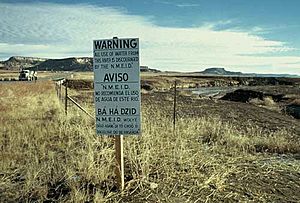Church Rock uranium mill spill facts for kids
Quick facts for kids UNC Church Rock |
|
|---|---|
| Superfund site | |
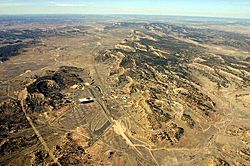
United Nuclear Corporation Church Rock mill site after clean-up
|
|
| Geography | |
| City | Gallup, New Mexico |
| County | McKinley |
| State | New Mexico |
| Coordinates | 35°39′03″N 108°30′23″W / 35.65083°N 108.50639°W |
| Information | |
| CERCLIS ID | NMD030443303 |
| Contaminants | Metals, radionuclides |
| Responsible parties |
United Nuclear Corporation |
| Progress | |
| Proposed | December 30, 1982 |
| Listed | August 8, 1983 |
| Construction completed |
August 29, 1998 |
| List of Superfund sites | |
The Church Rock uranium mill spill occurred in the U.S. state of New Mexico on July 16, 1979, when United Nuclear Corporation's tailings disposal pond at its uranium mill in Church Rock breached its dam. The accident remains the largest release of radioactive material in U.S. history, having released more radioactivity than the Three Mile Island accident four months earlier.
The mill, which operated from June 1977 to May 1982, was located on privately owned land about 17 miles (27 km) north of Gallup, New Mexico, and was bordered to the north and southwest by Navajo Nation Tribal Trust lands. The milling of uranium ore produced an acidic slurry of ground waste rock and fluid (tailings) that was pumped to the tailings disposal area. The breach released more than 1,100 short tons (1,000 t) of solid radioactive mill waste and 94 million US gallons (360,000 m3) of acidic, radioactive tailings solution into the Puerco River through Pipeline Arroyo. An estimated 1.36 short tons (1.23 t) of uranium and 46 curies of alpha contaminants traveled 80 miles (130 km) downstream to Navajo County, Arizona, and onto the Navajo Nation. In addition to being radioactive and acidic, the spill contained toxic metals and sulfates. The spill contaminated groundwater and rendered the Puerco unusable to local residents, mostly Navajo peoples who used the river's water for drinking, irrigation, and livestock. They were not warned for days of the toxic dangers from the spill.
The Governor of New Mexico Bruce King refused the Navajo Nation's request that the site be declared a federal disaster area, limiting aid to affected residents. The nuclear contamination event received less media coverage than that of Three Mile Island, possibly because it occurred in a very rural area not served by major media. The spill also happened in Native American country, among a community that at that time were not predisposed to speaking out.
In 2003, the Churchrock Chapter of the Navajo Nation began the Church Rock Uranium Monitoring Project to assess environmental impacts of abandoned uranium mines; it found significant radiation from both natural and mining sources in the area. The EPA National Priorities List currently includes the Church Rock tailings storage site, where "groundwater migration is not under control."
Contents
Dam failure
At around 5:30 am on July 16, 1979, a previously identified crack opened into 20-foot-breach (6.1 m) in the south cell of United Nuclear Corporation's Church Rock temporary uranium mill tailings disposal pond, and 1,100 short tons (1,000 t) of solid radioactive mill waste and about 93 million US gallons (350,000 m3) of acidic, radioactive tailings solution flowed into Pipeline Arroyo, a tributary of the Puerco River. Warnings of an impending spill had been ignored by the state and by United Nuclear Corporation. Though the uranium mill only bordered the Navajo Nation, the tailings spilled onto the Navajo Nation as they flowed down the Puerco River.
The tailings solution had a pH of 1.2 and a gross alpha particle activity of 128 nanocuries (4.7 kBq) per liter. In addition to radioactive uranium, thorium, radium and polonium, it also contained various other metals, including cadmium, aluminium, magnesium, manganese, molybdenum, nickel, selenium, sodium, vanadium, zinc, iron, and lead, and also high concentrations of sulfates. The contaminated water from the Church Rock spill traveled 80 miles (130 km) downstream, through Gallup, New Mexico, and reached as far as Navajo County, Arizona. The flood backed up sewers, affected nearby aquifers, and left stagnating, contaminated pools on the riverside.
As the highly acidic spill traveled downstream, alkaline soils and clays neutralized the acid and adsorbed many of the contaminants. The contaminated sediments were gradually dispersed by the river and diluted by “clean” sediment. In parts of the river system with higher concentrations of contaminants, yellow salt crystals precipitated onto the arroyo bed. These salts, containing metals and radionuclides, were washed away during subsequent rainstorms. Approximately one month after the spill, the Puerco River had regained normal levels of salinity, acidity, and radioactivity at low flow levels, with contaminants being detectable only after heavy rains. The EPA reported no long-term effects of the spill, but noted that contaminant levels from uranium mine effluents and natural sources were “environmentally significant”.
Causes
The dam formed the southern wall of one of the mill's three holding ponds, which were used to evaporate tailings solution until the remaining solid waste could be buried. From 1967 to 1982, the mill produced an average of 4,000 short tons (3,600 t) of tailings every day, for a total of 3.5 million short tons (3.2 Mt). The 35-foot (11 m) high embankment was constructed on a deposit of collapsible clayey, silty sand, one hundred feet (30 m) deep. United Nuclear used a new design, recommended by the Nuclear Regulatory Commission, that used earth rather than tailings themselves as building material. The holding pond was not lined, a violation of the Uranium Mill Tailings Radiation Control Act of 1978. This allowed tailings solution to seep into the ground, weakening the foundation of the dam and contaminating the groundwater.
Horizontal and vertical cracks formed along the southern part of the embankment, allowing the acidic tailings solution to penetrate and weaken the embankment. A sand beach was constructed to protect the face of the embankment from the tailings solution, but it was not properly maintained. The liquid in the holding pond eventually rose two feet (0.61 m) higher than the dam's designed limit, past the point where the sand beach could protect the dam. The United States Army Corps of Engineers concluded in its report to Governor Bruce King of New Mexico that the principal cause of failure was differential settlement of the foundation beneath the dam wall, and the report commissioned by the Nuclear Regulatory Commission corroborated this conclusion. Critical variations in tailings pond operation practice from approved procedures contributed further to the dam failure. United Nuclear's Chief Operating Officer, J. David Hann, blamed the failure of dam on the pointed shape of the bedrock beneath the embankment, which he said acted as a fulcrum and weakened the dam.
In December 1977, independent consultants spotted cracks in the dam wall. Three months later, United Nuclear sealed the cracks with bentonite and kerosene slurry but took little or no other action, despite the consultant's urging for regular inspections of the dam. Further cracking was noted in October 1978. Neither the facility owner nor the State Engineer were formally notified of the cracks, though Arizona representative Morris K. Udall testified before Congress that at least three federal and state agencies had "ample opportunity" to predict that the dam's failure was likely. At the same Congressional hearing, the United States Army Corps of Engineers testified that had the dam been built according to legal specifications, the failure would not have occurred.
Effects
Shortly after the breach, below the dam radioactivity levels of river water were 7000 times that of the allowable level of drinking water. United Nuclear initially claimed that only one curie of radioactivity had been released in the spill, but that figure was later revised upward by the New Mexico Environmental Improvement Division. In all, 46 curies (1.7 TBq) of radioactivity were released.
Prior to the spill, local residents used the riverside for recreation and herb-gathering, and children often waded in the Puerco River. Residents who waded in the river after the spill went to the hospital complaining of burning feet and were misdiagnosed with heat stroke. Burns acquired by some of those who came into contact with the contaminated water developed serious infections and required amputations. Herds of sheep and cattle died after drinking the contaminated water, and children played in pools of contaminated water. The spill contaminated shallow aquifers near the river that residents drank and used to water livestock. 1,700 people lost access to clean water after the spill. United Nuclear Corporation distributed 600 gallon-jugs of clean water, but the affected area required more than 30,000 US gallons (110,000 L; 25,000 imp gal) of water daily. The three community wells serving Church Rock had already been closed, one because of high radium levels and the other two for high levels of iron and bacteria. The Indian Health Service advised the tribe to repair five shallow wells along the Puerco River and said that the wells "are not expected to show any contamination, if at all, for several years." The Navajo Nation spent $100,000 on clean water, and in 1981, the New Mexico and federal governments stopped providing water, which they had delivered by truck since the spill.
An epidemiological study conducted by the NMEID in 1989 concluded that "the health risk to the public from eating exposed cattle is minimal, unless large amounts of this tissue, especially liver and kidney, are ingested." An Indian Health Service study found significantly higher levels of radionuclides in Church Rock cattle compared to livestock from non-mining areas. The study's authors advised that contamination would not pose a risk as long as residents did not depend on livestock for food over long periods of time, but local Navajos did. A few Navajo children were sent to Los Alamos to be checked for radiation exposure, but no long-term monitoring was undertaken, prompting a local writer to comment that the IHS spent more effort studying livestock than the people affected. No ongoing epidemiological studies have been done at Church Rock. Studies have shown since the 1950s that the Navajo have had significantly higher rates for some cancers than the national average, associated with contamination from the uranium mines and the exposure of workers to radiation.
Cleanup
United Nuclear dispatched small crews with shovels and 55-US-gallon (210 L; 46 imp gal) drums to begin cleanup, but expanded the workforce after complaints from local residents and pressure from the state. The crews removed three inches (76 mm) of sediment from the river bed, retrieving about 3,500 barrels (560 m3) of waste materials over the course of three months, but this amount was estimated as only 1% of the solid waste spilled. Groundwater remained contaminated by the spilled tailings solution, and rain transported leftover pollutants downstream into Arizona. New Mexico ordered United Nuclear to monitor pools left behind by the spill along the Puerco River, but United Nuclear measured only uranium levels, ignoring the presence of 230Th and 226Ra. The pools contained high levels of sulfuric acid and remained for more than a month after the spill, despite cleanup efforts by the New Mexico Environmental Improvement Division. The NMEID ordered United Nuclear to control tailings seepage from the mill in 1979, and the company implemented a limited seepage collective program in 1981.
The Navajo Nation appealed to the governor to request that the president declare the site a federal disaster area, but he refused, reducing the aid available to local residents. United Nuclear continued operation of the uranium mill until 1982, when it closed because of the declining uranium market.
United Nuclear neutralized the acidity of the tailings with ammonia and lime from 1979 to 1982. In 1983, the site was entered on the National Priorities List of the Environmental Protection Agency's Superfund investigations and cleanup efforts, as radionuclides and chemical constituents were found to be contaminating local groundwater. The EPA conducted a remedial investigation from 1984 to 1987, and in the NRC approved United Nuclear's closure and reclamation plan in 1988.
In 1994 the EPA extended its efforts with a study of all known uranium mines on the Navajo Nation. The EPA and United Nuclear removed 175,500 cubic feet (4,970 m3) of radium-contaminated soil surrounding five buildings, some residential, in 2007. The soil was moved to an off-site disposal facility.
In 2003 the Churchrock Chapter of the Navajo Nation began the Church Rock Uranium Monitoring Project to assess environmental impacts of abandoned uranium mines, and build capacity to conduct community-based research with policy implications. Its May 2007 report found radiation many times higher than background levels remaining in the area, from both natural and mining sources.
In 2008, the US Congress authorized a five-year plan for cleanup of contaminated uranium sites on the Navajo reservation.
See also
 In Spanish: Derrame del molino de uranio de Church Rock para niños
In Spanish: Derrame del molino de uranio de Church Rock para niños


